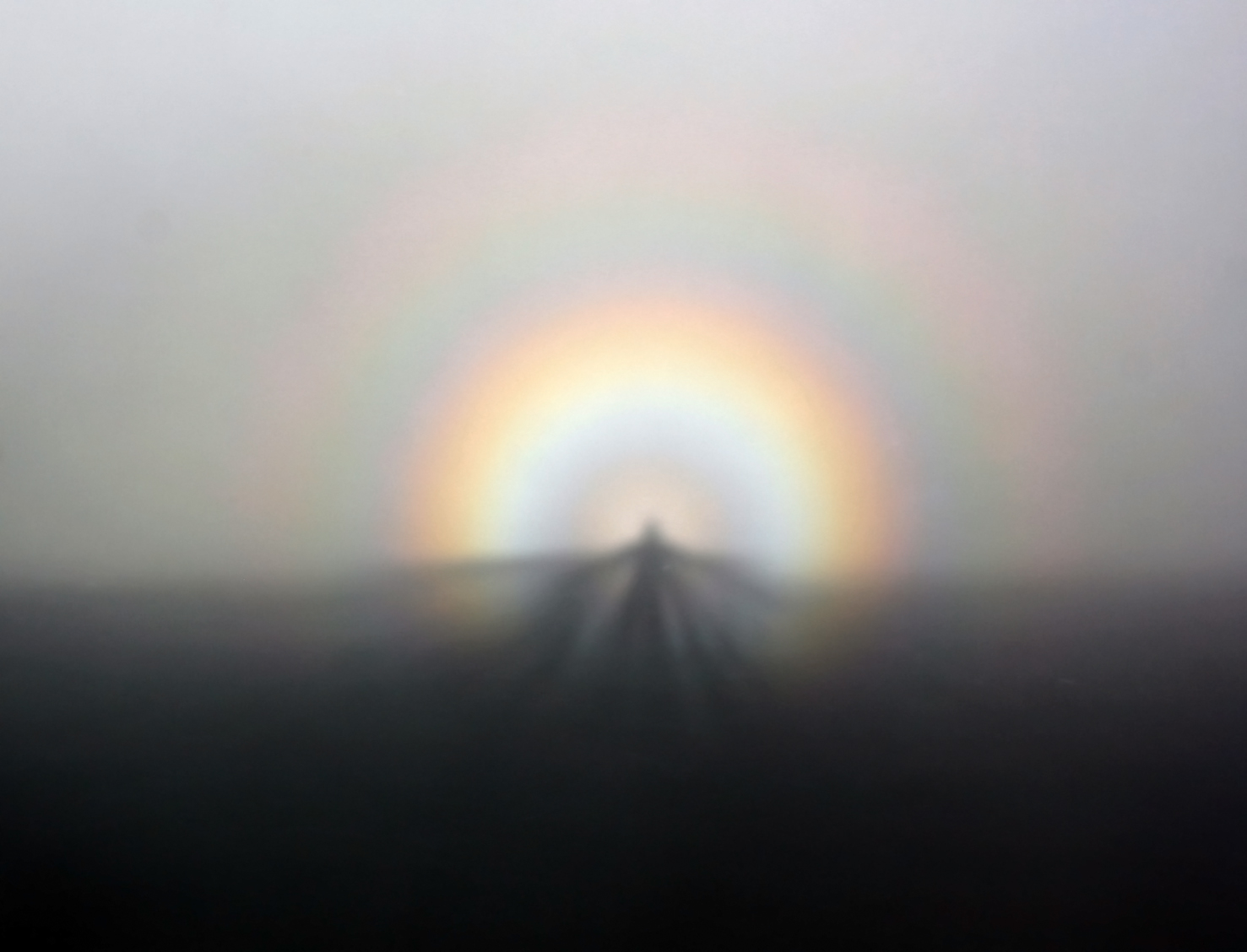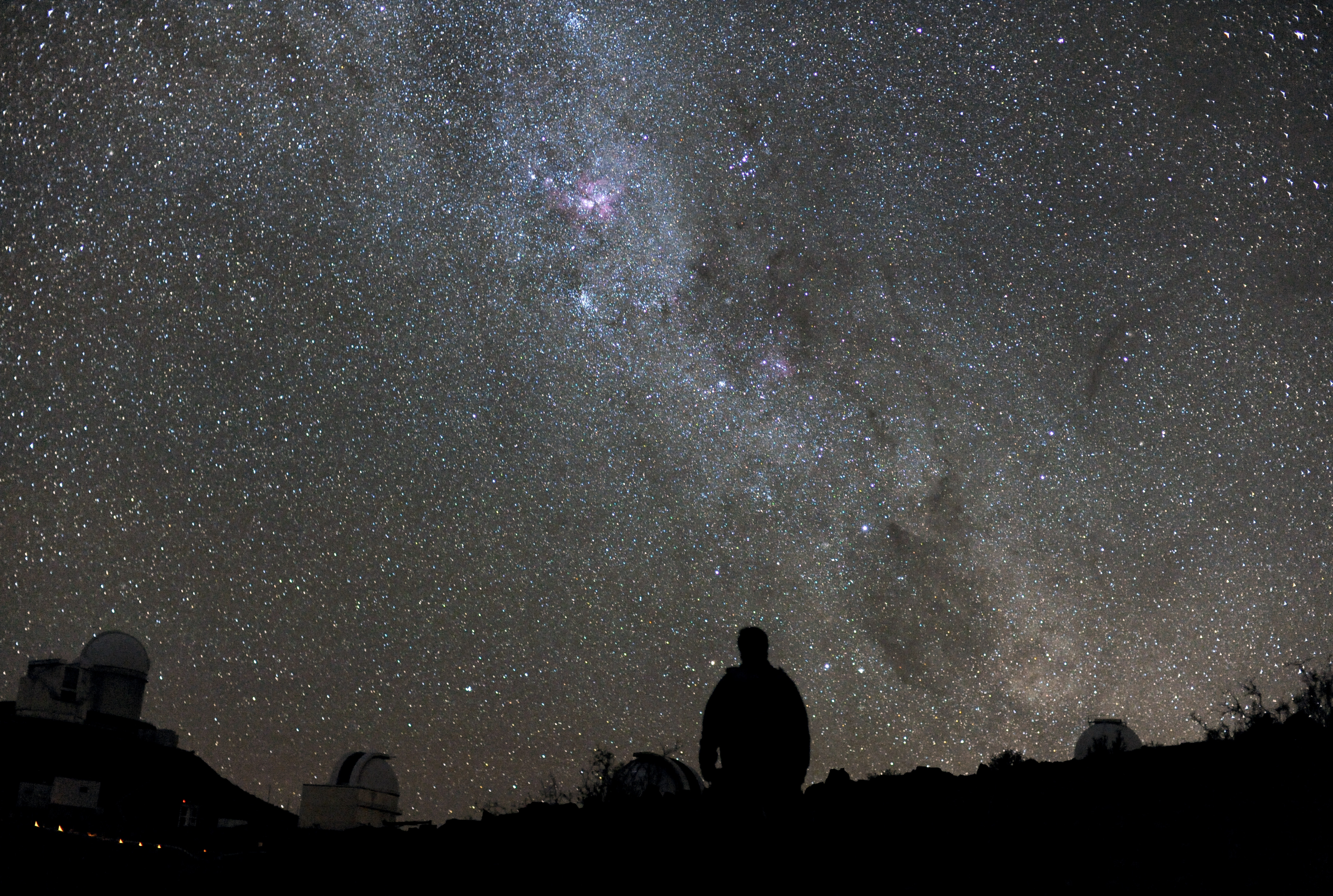|
Antisolar Point
The antisolar point is the abstract point on the celestial sphere directly opposite the Sun from an observer's perspective. This means that the antisolar point lies above the horizon when the Sun is below it, and vice versa. On a sunny day, the antisolar point can be easily found; it is located within the shadow of the observer's head. Like the zenith and nadir, the antisolar point is not fixed in three-dimensional space, but is defined relative to the observer. Each observer has an antisolar point that moves as the observer changes position. The antisolar point forms the geometric center of several optical phenomena, including subhorizon haloes, rainbows, glories, the Brocken spectre, and heiligenschein. Occasionally, around sunset or sunrise, anticrepuscular rays appear to converge toward the antisolar point near the horizon. However, this is an optical illusion caused by perspective; in reality, the "rays" (i.e. bands of shadow) run near-parallel to each other. Also ... [...More Info...] [...Related Items...] OR: [Wikipedia] [Google] [Baidu] |
Brocken Spectre
A Brocken spectre (British English; American spelling: Brocken specter; ), also called Brocken bow, mountain spectre, or spectre of the Brocken is the magnified (and apparently enormous) shadow of an observer cast in mid air upon any type of cloud opposite a strong light source. The figure's head can be surrounded by a bright area called , or Halo (optical phenomenon), halo-like rings of rainbow-coloured light forming a glory (optical phenomenon), glory, which appear opposite the Sun's direction when uniformly sized water droplets in clouds refract and backscatter sunlight. The phenomenon can appear on any misty mountainside, cloud bank, or be seen from an aircraft, but the frequent fogs and low-altitude accessibility of the Brocken, the highest peak of the Harz Mountains in Germany, have created a local legend from which the phenomenon draws its name. The Brocken spectre was observed and described by Johann Silberschlag in 1780, and has often been recorded in literature about t ... [...More Info...] [...Related Items...] OR: [Wikipedia] [Google] [Baidu] |
Astronomy
Astronomy is a natural science that studies celestial objects and the phenomena that occur in the cosmos. It uses mathematics, physics, and chemistry in order to explain their origin and their overall evolution. Objects of interest include planets, natural satellite, moons, stars, nebulae, galaxy, galaxies, meteoroids, asteroids, and comets. Relevant phenomena include supernova explosions, gamma ray bursts, quasars, blazars, pulsars, and cosmic microwave background radiation. More generally, astronomy studies everything that originates beyond atmosphere of Earth, Earth's atmosphere. Cosmology is a branch of astronomy that studies the universe as a whole. Astronomy is one of the oldest natural sciences. The early civilizations in recorded history made methodical observations of the night sky. These include the Egyptian astronomy, Egyptians, Babylonian astronomy, Babylonians, Greek astronomy, Greeks, Indian astronomy, Indians, Chinese astronomy, Chinese, Maya civilization, M ... [...More Info...] [...Related Items...] OR: [Wikipedia] [Google] [Baidu] |
Interplanetary Dust
The interplanetary dust cloud, or zodiacal cloud (as the source of the zodiacal light), consists of cosmic dust (small particles floating in outer space) that pervades the space between planets within planetary systems, such as the Solar System. This system of particles has been studied for many years in order to understand its nature, origin, and relationship to larger bodies. There are several methods to obtain space dust measurement. In the Solar System, interplanetary dust particles have a role in scattering sunlight and in emitting thermal radiation, which is the most prominent feature of the night sky's radiation, with wavelengths ranging 5–50 μm. The particle sizes of grains characterizing the infrared emission near Earth's orbit typically range 10–100 μm. Microscopic impact craters on lunar rocks returned by the Apollo Program revealed the size distribution of cosmic dust particles bombarding the lunar surface. The ’’Grün’’ distribution of interplanetar ... [...More Info...] [...Related Items...] OR: [Wikipedia] [Google] [Baidu] |
Sunlight
Sunlight is the portion of the electromagnetic radiation which is emitted by the Sun (i.e. solar radiation) and received by the Earth, in particular the visible spectrum, visible light perceptible to the human eye as well as invisible infrared (typically perceived by humans as warmth) and ultraviolet (which can have physiological effects such as sunburn) lights. However, according to the American Meteorological Society, there are "conflicting conventions as to whether all three [...] are referred to as light, or whether that term should only be applied to the visible portion of the spectrum." Upon reaching the Earth, sunlight is light scattering by particles, scattered and attenuation, filtered through the atmosphere of Earth, Earth's atmosphere as daylight when the Sun is above the horizon. When direct solar radiation is not blocked by clouds, it is experienced as sunshine, a combination of bright light and radiant heat (atmospheric). When cloud cover, blocked by clouds or dif ... [...More Info...] [...Related Items...] OR: [Wikipedia] [Google] [Baidu] |
Backscatter
In physics, backscatter (or backscattering) is the reflection of waves, particles, or signals back to the direction from which they came. It is usually a diffuse reflection due to scattering, as opposed to specular reflection as from a mirror, although specular backscattering can occur at normal incidence with a surface. Backscattering has important applications in astronomy, photography, and medical ultrasonography. The opposite effect is forward scatter, e.g. when a translucent material like a cloud diffuses sunlight, giving soft light. Backscatter of waves in physical space Backscattering can occur in quite different physical situations, where the incoming waves or particles are deflected from their original direction by different mechanisms: *Diffuse reflection from large particles and Mie scattering, causing alpenglow and gegenschein, and showing up in weather radar; *Inelastic collisions between electromagnetic waves and the transmitting medium ( Brillouin scattering ... [...More Info...] [...Related Items...] OR: [Wikipedia] [Google] [Baidu] |
Light Pollution
Light pollution is the presence of any unwanted, inappropriate, or excessive artificial Visible spectrum, lighting. In a descriptive sense, the term ''light pollution'' refers to the effects of any poorly implemented lighting sources, during the day or night. Light pollution can be understood not only as a phenomenon resulting from a specific source or kind of pollution, but also as a contributor to the wider, collective impact of various sources of pollution. Although this type of pollution can exist throughout the day, its effects are magnified during the night with the contrast of the sky's darkness. It has been estimated that 83% of the world's people live under light-polluted skies and that 23% of the world's land area is affected by skyglow. The area affected by artificial illumination continues to increase. A major side effect of urbanization, light pollution is blamed for compromising health, disrupting ecosystems, and spoiling aesthetic environments. Studies show that ur ... [...More Info...] [...Related Items...] OR: [Wikipedia] [Google] [Baidu] |
Night Sky
The night sky is the nighttime appearance of celestial objects like stars, planets, and the Moon, which are visible in a clear sky between sunset and sunrise, when the Sun is below the horizon. Natural light sources in a night sky include moonlight, starlight, and airglow, depending on location and timing. Aurorae light up the skies above the polar circles. Occasionally, a large coronal mass ejection from the Sun or simply high levels of solar wind may extend the phenomenon toward the Equator. The night sky and studies of it have a historical place in both ancient and modern cultures. In the past, for instance, farmers have used the status of the night sky as a calendar to determine when to plant crops. Many cultures have drawn constellations between stars in the sky, using them in association with legends and mythology about their deities. The history of astrology has generally been based on the belief that relationships between heavenly bodies influence or explain events on Ear ... [...More Info...] [...Related Items...] OR: [Wikipedia] [Google] [Baidu] |
Gegenschein
Gegenschein (; ; ) or counterglow is a faintly bright spot in the night sky centered at the antisolar point. The backscatter of sunlight by interplanetary dust causes this optical phenomenon, being a zodiacal light and part of its zodiacal light band. Explanation Like zodiacal light, gegenschein is sunlight light scattering by particles, scattered by interplanetary dust cloud, interplanetary dust. Most of this dust orbits the Sun near the ecliptic plane, with a possible concentration of particles centered at the point of the Earth–Sun system. Gegenschein is distinguished from zodiacal light by its high angle of incidence (optics), angle of reflection of the incident sunlight on the dust particles. It forms a slightly brighter elliptical spot of 8–10° across opposition (astronomy), directly opposite the Sun within the dimmer band of zodiacal light and zodiac constellation. The intensity of the gegenschein is opposition surge, relatively enhanced because each dust par ... [...More Info...] [...Related Items...] OR: [Wikipedia] [Google] [Baidu] |
Optical Illusion
In visual perception, an optical illusion (also called a visual illusion) is an illusion caused by the visual system and characterized by a visual perception, percept that arguably appears to differ from reality. Illusions come in a wide variety; their categorization is difficult because the underlying cause is often not clear but a classification proposed by Richard Gregory is useful as an orientation. According to that, there are three main classes: physical, physiological, and cognitive illusions, and in each class there are four kinds: Ambiguities, distortions, paradoxes, and fictions. A classical example for a physical distortion would be the apparent bending of a stick half immersed in water; an example for a physiological paradox is the motion aftereffect (where, despite movement, position remains unchanged). An example for a physiological fiction is an afterimage. Three typical cognitive distortions are the Ponzo illusion, Ponzo, Poggendorff illusion, Poggendorff, and M� ... [...More Info...] [...Related Items...] OR: [Wikipedia] [Google] [Baidu] |
Anticrepuscular Rays
Anticrepuscular rays, or antisolar rays, are meteorological optics, meteorological optical phenomenon, optical phenomena similar to crepuscular rays, but appear opposite the Sun in the sky. Anticrepuscular rays are essentially parallel (geometry), parallel, but appear to converge toward the antisolar point, the vanishing point, due to a visual illusion from linear perspective. Anticrepuscular rays are most frequently visible around dawn or dusk. This is because the atmospheric light scattering by particles, light scattering that makes them visible (backscattering) is larger for low angles to the horizon than most other angles. Anticrepuscular rays are dimmer than crepuscular rays because backscattering is less than forward scattering. Anticrepuscular rays can be continuous with crepuscular rays, curving across the whole sky in great circles.Lynch, D. K., & Livingston, W. (1995). Color and light in nature. Cambridge: Cambridge University Press. Mountain shadow A common examp ... [...More Info...] [...Related Items...] OR: [Wikipedia] [Google] [Baidu] |










